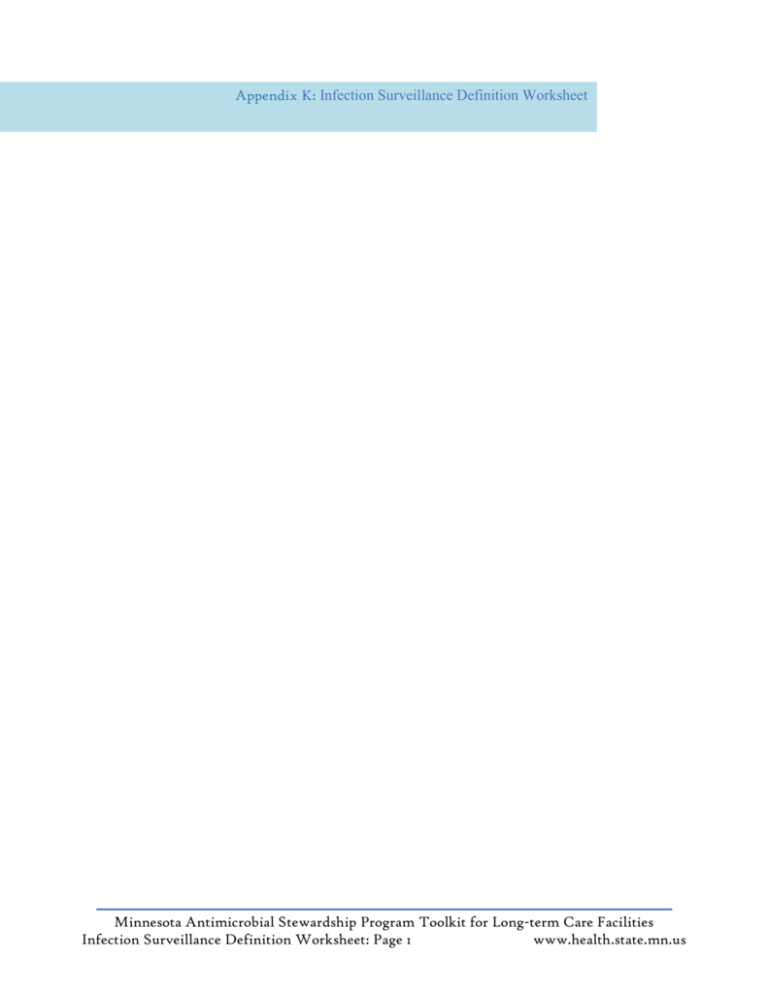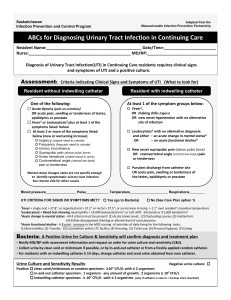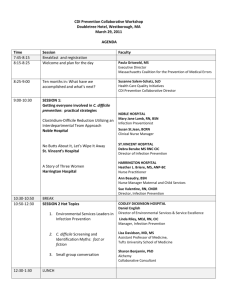Date
advertisement

Appendix K: Infection Surveillance Definition Worksheet Minnesota Antimicrobial Stewardship Program Toolkit for Long-term Care Facilities Infection Surveillance Definition Worksheet: Page 1 www.health.state.mn.us Infection Surveillance Definition Worksheet Date MRN M/F MDRO Admit Hospitalized HAI Type of Infection Onset Culture Result Type of Infection () Infection/Site Last Name, First Name, MI Date of Birth PMH Provider Narrative Notes Lab, Imaging Procedures Criteria (symptoms must be new or increased) Location Conditions/Comments Respiratory Tract □ Common cold syndrome □ Or pharyngitis MUST HAVE at least 2 of the following: □ Runny nose or sneezing □ Stuffy nose (nasal congestion) □ Sore throat or hoarseness or difficulty swallowing □ Dry cough □ Swollen or tender glands in neck (cervical lymphadenopathy) Fever may or may not be present. Symptoms must be new and not attributable to allergies. □ Influenza-like illness MUST HAVE: □ Fever (≥ 100˚F taken at any site) AND MUST HAVE at least 3 of the following: □ Chills □ Malaise or loss of appetite □ Headache or eye pain □ Sore throat □ Mylagia/body aches □ New or increased dry cough If criteria for influenza-like illness and another upper or lower RTI are met at the same time, only the diagnosis of influenzalike illness should be recorded. Because of increasing uncertainty surrounding the timing of the start of influenza season, the peak of influenza activity, and the length of the season, “seasonality” is no longer a criterion to define influenza-like illness. □ Pneumonia MUST HAVE: □ Chest x-ray demonstrating pneumonia, probable pneumonia or new infiltrate. AND MUST HAVE at least 1 of the following: □ New or increased cough □ 02 sat <94% or < 3% baseline □ Pleuritic chest pain □ Fever (See Constitutional Criteria: Table 2) □ New or increased sputum production □ New or changed lung exam abnormalities □ Respiratory rate (>25/minute) AND MUST HAVE at least 1 of the constitutional criteria (See Constitutional Criteria: Table 2) For both pneumonia and lower RTI, the presence of underlying conditions that could mimic the presentation of a RTI (eg, congestive heart failure or interstitial lung diseases) should be excluded by a review of clinical records and an assessment of presenting symptoms and signs. □ Lower respiratory tract infection (bronchitis, tracheobronchitis) MUST HAVE at least 3 of the following: □ CXR not performed or negative results for pneumonia or new infiltrate □ At least 2 of respiratory subcriteria in pneumonia (above) □ At least 1 of the constitutional criteria (See Constitutional Criteria: Table 2) NOTE: This diagnosis can be made only if NO Chest x-ray was done OR if a CXR fails to confirm diagnosis of pneumonia. For both pneumonia and lower RTI, the presence of underlying conditions that could mimic the presentation of a RTI (e.g. congestive heart failure or interstitial lung diseases) should be excluded by a review of clinical records and assessment of s/sx Did resident receive influenza vaccine for this flu season? □ YES □ NO Minnesota Antimicrobial Stewardship Program Toolkit for Long-term Care Facilities Infection Surveillance Definition Worksheet: Page 2 www.health.state.mn.us □ UTI in resident WITHOUT catheter (any previous catheter must have been D/C’d at least 48 hrs before symptoms began) Urinary Tract Infection □ UTI in resident WITH catheter (if symptoms begin within 48 hrs after discontinuing a catheter, count it as related to catheter) MUST HAVE BOTH Criteria 1 and 2: Criteria 1. MUST HAVE at least 1 of the following: □ Acute dysuria or acute pain, swelling, or tenderness of the testes, epididymis, or prostate □ Fever or leukocytosis (See Constitutional Criteria: Table 2) AND at least 1 of the following: □ Acute costovertebral angle pain or tenderness □ Suprapubic pain □ Gross hematuria □ New or marked increase in incontinence □ New or marked increase in urgency □ New or marked increase in frequency OR In the absence of fever or leukocystosis, 2 or more of the following: □ Suprapubic pain □ Gross hematuria □ New or marked increase in incontinence □ New or marked increase in urgency □ New or marked increase in frequency AND Criteria 2. MUST HAVE 1 of the following: □ At least 105 cfu/mL of no more than 2 species of microorganisms in a voided urine sample □ At least 102 cfu/mL of any number of organisms in a specimen collected by in-and-out catheter UTI should be diagnosed when there are localizing genitourinary signs and symptoms and a positive urine culture result. A diagnosis of UTI can be made without localizing symptoms if a blood culture isolate is the same as the organism isolated from the urine and there is no alternate site of infection. In the absence of a clear alternate source of infection, fever or rigors with a positive urine culture result in the non-catheterized resident or acute confusion in the catheterized resident will often be treated as UTI. However, evidence suggests that most of these episodes are likely not due to infection of a urinary source. MUST HAVE BOTH Criteria 1 and 2: Criteria 1. MUST HAVE at least 1 of the following: □ Fever, rigors, or new-onset hypotension, with no alternate site of infection □ Either acute change in mental status or acute functional decline, with no alternate site of infection □ New-onset suprapubic pain or costovertebral angle pain or tenderness □ Purulent discharge from around the catheter or acute pain, swelling, or tenderness of the testes, epididymis, or prostate AND Criteria 2. MUST HAVE: □ Urinary catheter specimen culture with at least 10 5 cfu/mL of any organism(s) UTI should be diagnosed when there are localizing genitourinary signs and symptoms and a positive urine culture result. A diagnosis of UTI can be made without localizing symptoms if a blood culture isolate is the same as the organism isolated from the urine and there is no alternate site of infection. In the absence of a clear alternate source of infection, fever or rigors with a positive urine culture result in the non-catheterized resident or acute confusion in the catheterized resident will often be treated as UTI. However, evidence suggests that most of these episodes are likely not due to infection of a urinary source. Urine specimens for culture should b e processed as soon as possible, preferably within 1–2 h. If urine specimens cannot be processed within 30 min of collection, they should be refrigerated. Refrigerated specimens should be cultured within 24 h. Recent catheter trauma, catheter obstruction, or new-onset hematuria are useful localizing signs that are consistent with UTI but are not necessary for diagnosis. Urinary catheter specimens for culture should be collected following replacement of the catheter (if current catheter in place for >14 days). Minnesota Antimicrobial Stewardship Program Toolkit for Long-term Care Facilities Infection Surveillance Definition Worksheet: Page 3 www.health.state.mn.us GastroIntestinal □ Gastroenteritis MUST HAVE at least 1 of the following: □ Diarrhea: 3 or more liquid or watery stools above what is normal for the resident within a 24-hour period □ Vomiting: 2 or more episodes in a 24-hour period OR BOTH of the following: □ A stool specimen testing positive for a pathogen (eg, Salmonella, Shigella, Escherichia coli O157 : H7, Campylobacter species, rotavirus) □ At least one of the following: □ Nausea □ Vomiting □ Abdominal pain or tenderness □ Diarrhea Care must be taken to exclude noninfectious causes of symptoms. For instance, new medications may cause diarrhea, nausea, or vomiting; initiation of new enteral feeding may be associated with diarrhea; and nausea or vomiting may be associated with gallbladder disease. Presence of new GI symptoms in a single resident may prompt enhanced surveillance for additional cases. In the presence of an outbreak, stool specimens should be sent to confirm the presence of norovirus or other pathogens (e.g., rotavirus or E. coli O157 : H7) □ Norovirus Gastroenteritis MUST HAVE BOTH Criteria 1 and 2: Criteria 1. MUST HAVE at least 1 of the following: □ Diarrhea: 3 or more liquid or watery stools above what is normal for the resident within a 24-hour period □ Vomiting: 2 or more episodes in a 24-hour period AND Criteria 2. MUST HAVE: □ A stool specimen for which norovirus is positively detected by electron microscopy, enzyme immunoassay, or molecular diagnostic testing such as polymerase chain reaction (PCR) In the absence of laboratory confirmation, an outbreak (2 or more cases occurring in a long-term care facility [LTCF] ) of acute gastroenteritis due to norovirus infection may be assumed to be present if all of the following criteria are present (“Kaplan Criteria”): (a) vomiting in more than half of affected persons; (b) a mean (or median) incubation period of 24-48 hours; (c) a mean (or median) duration of illness of 12-60 hours; and (d) no bacterial pathogen is identified in stool culture. □ Clostridium difficile infection MUST HAVE BOTH Criteria 1 and 2: Criteria 1. MUST HAVE at least 1 of the following: □ Diarrhea: 3 or more liquid or watery stools above what is normal for the resident within a 24-hour period □ Presence of toxic megacolon (abnormal dilatation of the large bowel, documented radiologically) AND Criteria 2. MUST HAVE at least 1 of the following: □ A stool sample yields a positive laboratory test result for C. difficile toxin A or B, or a toxin producing C. difficile organism is identified from a stool sample culture or by a molecular diagnostic test such as PCR □ Pseudomembranous colitis is identified during endoscopic examination or surgery or in histopathologic examination of a biopsy specimen A “primary episode” of C. difficile infection is defined as one that has occurred without any previous history of C. difficile infection or that has occurred >8weeks after the onset of a previous episode of C. difficile infection. A “recurrent episode” of C. difficile infection is defined as an episode of C. difficile infection that occurs 8 weeks or sooner after the onset of a previous episode, provided that the symptoms from the earlier (previous) episode have resolved. Individuals previously infected with C. difficile may continue to remain colonized even after symptoms resolve. In the setting of an outbreak of GI infection, individuals could have positive test results for presence of C. difficile toxin because of ongoing colonization and also be co-infected with another pathogen. It is important that other surveillance criteria be used to differentiate infections in this situation. Minnesota Antimicrobial Stewardship Program Toolkit for Long-term Care Facilities Infection Surveillance Definition Worksheet: Page 4 www.health.state.mn.us □ Skin NOTE: Assure that personnel wear gloves for contact with rash or skin lesions and perform hand hygiene after glove removal □ Cellulitis/soft tissue/wound □ Scabies MUST HAVE at least 1 of the following: □ Pus present at a wound, skin, or soft tissue site □ New or increasing presence of at least 4 of the following: □ Heat at the affected site □ Redness at the affected site □ Swelling at the affected site □ Tenderness of pain at the affected site □ Serous drainage at the affected site AND □ At least 1 of the constitutional criteria (See Constitutional Criteria: Table 2) Presence of organisms cultured from the surface (eg, superficial swab sample) of a wound is not sufficient evidence that the wound is infected. More than 1 resident with streptococcal skin infection from the same serogroup (eg, A, B, C, G) in a longterm care facility (LTCF) may indicate an outbreak. MUST HAVE BOTH Criteria 1 and 2: Criteria 1. MUST HAVE: □ A maculopapular and/or itching AND Criteria 2. MUST HAVEat least one of the following: □ Physician diagnosis □ Laboratory confirmation (scraping or biopsy) □ Epidemiologic linkage to a case of scabies with laboratory confirmation An epidemiologic linkage to a case can be considered if there is evidence of geographic proximity in the facility, temporal relationship to the onset of symptoms, or evidence of common source of exposure (ie, shared caregiver). Care must be taken to rule out rashes due to skin irritation, allergic reactions, eczema, and other noninfectious skin conditions. Table 2: Definitions for Constitutional Criteria in Residents of Long-Term Care Facilities (LTCFs) Fever 1. Leukocytosis Acute change in mental status from baseline Acute functional decline Single oral temperature >37.8 °C (100°F ) OR 2. Repeated oral temperatures >37.2 °C (99°F) OR 3. Single temperature >1.1 °C (2°F) over baseline from any site (oral, tympanic, axillary) 1. Neutrophilia (>14,000 leukocytes/mm3) OR 2. Left shift (>6% bands or ≥1,500 bands/mm3) All criteria must be present: 1. Acute onset (Evidence of acute change in resident’s mental status from baseline) 2. Fluctuating course (Behavior fluctuating: eg, coming and going or changing in severity during the assessment) 3. Inattention (Resident has difficulty focusing attention: eg, unable to keep track of discussion or easily distracted) 4. Either disorganized thinking or altered level of consciousness a. Disorganized thinking (Resident’s thinking is incoherent: eg, rambling conversation, unclear flow of ideas, unpredictable switches in subject) OR b. Altered level of consciousness (Resident’s level of consciousness is described as different from baseline: eg, hyperalert, sleepy, drowsy, difficult to arouse, nonresponsive) 1. A new 3-point increase in total activities of daily living (ADL) score (range, 0-28) from baseline, based on the following 7 ADL items, each scored from 0 (independent) to 4 (total dependence) Bed mobility, transfer, locomotion within LTCF, dressing, toilet use, personal hygiene, eating Minnesota Department of Health Infectious Disease Epidemiology, Prevention and Control Division 651-201-5414 www.health.state.mn.us 1-877-676-5414 12/2014 Minnesota Antimicrobial Stewardship Program Toolkit for Long-term Care Facilities Infection Surveillance Definition Worksheet: Page 5 www.health.state.mn.us







